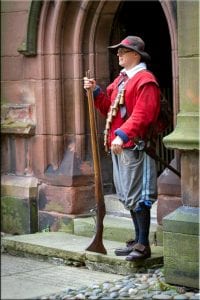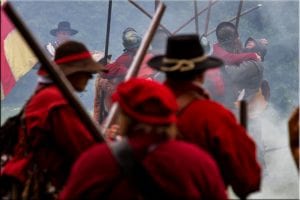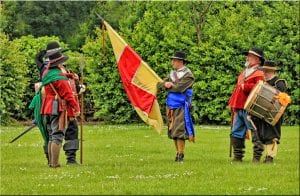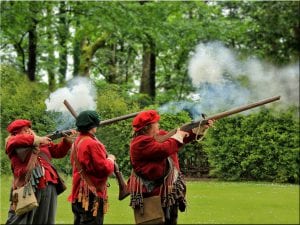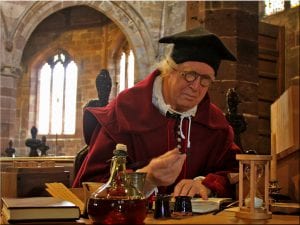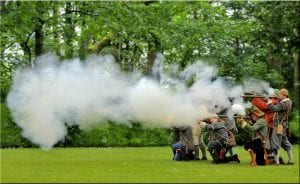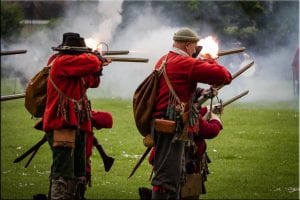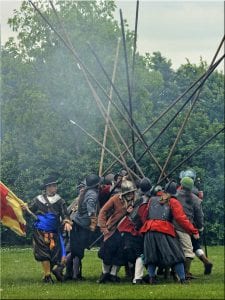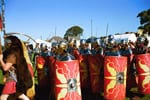MIDDLEWICH IN THE CIVIL WAR
A tale of two battles of great consequence. This category contains research from various authors and edited by Kerry Fletcher. The research was in support of Middlewich Town Council’s Civil War event. It is spread across Four articles looking at ‘What Started The English Civil War’, ‘The First Battle of Middlewich’, ‘The Second Battle of Middlewich’ and ‘Who’s Who’.
If you prefer you may click here to open the full document in pdf format.
Please click on the section you require.
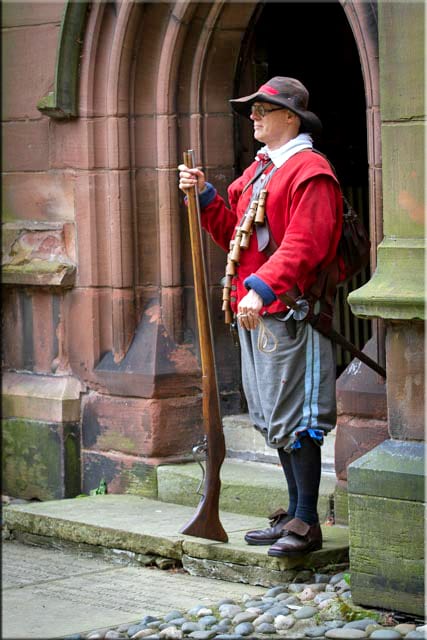
WHAT STARTED THE ENGLISH CIVIL WAR?
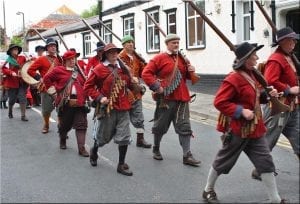
Charles I believed he should govern the people by Royal rights without the advice and consent of Parliament.
Parliament insisted in a necessary role in Government particularly in taxes and grievances of the people towards their King. Charles I forced loans and taxes to raise revenue (especially for war purposes) and imprisoned those who refused to pay.
Parliament wanted to raise these issues with the King. Charles I dissolved Parliament for 11 years and governed the country himself. In November 1640 Parliament was re-instated. The following year there was a grand remonstrance (petition) against Charles I activities passed in the commons.
In January 1642 Charles I entered the commons, fully armed, to arrest 5 members of the House, who had already fled.
By March 1642 the Militia Ordinance bill passed establishing Parliament control over the County Militias. Charles I raised his standard at Nottingham thereby starting the English Civil War.
Charles I was defeated in June 1646. Although under arrest forces still fought for Charles I, battles continued in areas of Wales, Scotland and Ireland until 1651. Charles I faced charges of tyranny and treason, he challenged the courts authority and its right to try him. The trial started on 9th January 1649 and the death sentence was proclaimed 27th January.
The Loss of over Five hundred prisoners and the flight of Sir Thomas Aston – The making of Sir William Brereton
AND
A Great Victory by John, 1st Lord Byron
A Presentation of historical snippets from initial research into the Civil War at Middlewich, an arrangement of our resources and places of further information.
THE FIRST BATTLE OF MIDDLEWICH
Aston was told unmistakably that he must prevent Brereton from spreading his power: he
broke up one parliamentary rendezvous at Tarporley and when Brereton rode off with his horsemen to recruit in Northwich he followed to Middlewich. There he had three cannon, his own horse and over a thousand of the trained bands of the Broxton and Wirral hundreds, and hoped to bring in more from the tenants of Lord Brereton, whose main estate lay a little to the south-east. But he was in an open town and Brereton, sensing an opportunity, sent to Nantwich for foot to co-operate in a two-pronged dawn attack. At the appointed hour on 13 March they were not there; nevertheless Brereton probed with his horsemen all-round the western approaches to the town. He was easily held but when, a few hours later, the Nantwich foot came marching up Booth’s Lane from the south, the effort to change front to meet a fresh attack was too much for Aston’s inexperienced forces’. R N Dore, the Civil Wars in Cheshire pg. 26-27
A very personal account… This was handwritten from Castle records by P Cowper.
This stands as a primary source account from Sir Thomas Aston himself and his contempories
“On Fryday, March the tenth, Sr Thomas Aston came out of Chester, with some Troops of Horse, and several Companies of Foot, and the next morning came to Middlewich, and endeavoured to make that Town as defensible as could be done in the space of twenty four hours. On Sunday Sir William Brereton, with his Party, went from Northwich, and approached the lodgments of the advanced Guards of the Chester men on Spital Hill, within Stanthorn, near to Middlewich and, after some firings, returned to his Quarters, having dispatched an Express with his Orders, to the Commanding Officer at Namptwich. On Monday early he came again from Northwich, and having forced the outguards from their post just before mentioned, proceeded to the Heath, within Newton, near to the west side of Middlewich, where a smart engagement began, and continued nearly equal as to advantage, till about ten a clock, when eleven hundred Horse and Foot from Namptwich arrived at the Southern entrance of the Town, from towards Booth Lane, in which approach, Sr Thomas Aston had planted a piece of brass cannon, and made as good dispositions as the situation would admit of. This numerous reinforcement, to avoid the cannonading, got over the Fences on each side of the lane, and many very sharp vollies were exchanged between them, and the Defendants, who at length began to give way, when the Namptwich men pushing on very vigorously, beat off the Gunners and took the Piece of Ordnance, and then made their way up to the middle of the Town, meeting but with faint resistance from their scattered adversaries, Sr Thomas Aston perceiving his men rousted, and the Place lost, He, and Colonel Leigh of Adlington, then High Sheriff of Cheshire, made the best retreat that they could, up Kinderton Street, towards Hulmes Chapell, in which they met with little opposition from the Enemy, who were busily employed in plundering the Houses, and securing and stripping the Prisoners, among whom were Sr Edward Mosely of Lancashire Baronet, Colonel Ellis, Major Gillmore, Captains Corbet, Morris, Lloyd, Eaton, Massie of Coddington, Hurleston, Jones, Horton, Starkie of Stretton, and Davenport of Woodford; Lieutenants Dod, Chorley, Jennings, Hosier, and Manley; Ensigns Ward, Proudlove, Norreys and Davenport; three Cannoniers, Hardinge, Gorton and Yates; Corporals Lea and Gleave; two Quartermasters and about four hundred private men. Besides one hundred Horse, there was likewise taken two pieces of Ordnance, four barrels of powder, and two barrels of matches, and Arms for between four and five hundred Soldiers, the number of the slain was not great and near equal on both sides, and no Officer fell in this Action; but the Townsmen were great sufferers in their properties. They were despoiled of their moveables, and the Church was robbed of its Plate, and whatever else was worth taking.
Sir Thomas Aston, in a few days afterwards, though not without difficulty, got back to Chester, where he was much censured concerning the Affair at Middlewich, was put under an Arrest and ordered so to remain, at Pulford a small Town or Village in Cheshire on the confines of Denbighshire, and about the midway between Chester and Wrexham: whilst he was in that situation he drew up a State of his Case, by way of a vindication of his Conduct, and addressed the same to the Lords, and others of the Garrison at Chester, which Piece, literally transcribed from a manuscript: Copy is as follows:
“To the Right Honourable, the Earl Rivers, the Lords Viscounts Cholmondeley, and Kilmurrey; to the Hon’ble Thomas Savage, etc. etc. etc: My Lords! Though I know not what it is to apprehend feare of any mans threates, nor know any cause given for them against mee in particular, yet I must thanke your care of my Person, and shall have more cause to acknowledge your sense of my Honour, if you will receave and divulge a true Accompt of this unfortunate business, wherein I desire noe favour, but that truth may be knowne, and let that quitt or condemne mee.
“Your Lordships know how our progresse was retarded at our setting foorth; the Soldiers mutininge for pay on the Fryday; and Mr Bavand haveinge not issued it out on Saturday, nor the provisions, ‘till it was soe late, I was forced to leave two troops of Horse on the fforrest to guard it to Over, though they lay in danger that night.
“At our arrivall at Midellwich, a letter overtooke us from the Governour, recommendinge to us certaine Propositions from the Lord Brereton, which were,
“That he might have a convoye for his Ladie, children and Goods to Chester, and then he would bringe in his Men. Upon consultation had with the Sheriff, Sr Edward Fytton and Colonel Ellis, it was held for a considerable addition, and that it was worth our stay, and thereupon sent him a letter under all our hands, desiringe though it were Sunday, he would provide carriage for his goods and come away, for that further delays would not be safe for him, nor could our Designs admit it; yet his Lordship did not accordingly, but came on Sunday himselfe to Midelwich, to confer further with us. Of this Notice was very speedilie given to Northwich (as by intelligence since from them) which occasioned the suddaine attempt upon us, to prevent him from joyninge with us, whose intentions were judged by this appearance.
“The accommodatinge this, togaither with the Sherife’s desire to summon in the Country, with theire contribution and assistance, necessitated a joynte consent to stay there on Monday, the rather hopeinge diversion of danger from Namptwich, by prayinge the Governour, that they, at that place, might receave an allarum from Whitchurch Forces; but in steed of a support or countenance from that Quarter, the Forces there were disbanded, and to whatever accident we studie to impute the miscarriage of this Designe, that was the ruine of this, and (I pray God it prove not soe) of both Counties.
“Theire whole force and power, beinge therebye let loose upon us, to assaile us on three sides, in an open towne, and where it was impossible for Horse to doe service, yet the imputation of the misfortune must be laid upon the Horse.
“Theire dutie was not neglected. On one passage to the enemie a Party of Dragoniers under Captaine Spotswood’s command was ordered to give them an alarum at Northwich (though with more caution than it was executed), the Lieutenant improvidently engageinge himself where he was expressly forbid, soe that way was secured.
“Captaine Prestwich was lodged at the other passage, and his scoutes discovered them, though they followed soe close that they fell upon some of his Men, ‘ere they could cleere theire scattered quarters; but he chased them back to theire foote, rescued some prisoners, at the Bridge he wheeled aboute, and kept them at a stand, ‘till the Foote came down.
“At theire approach before the Bridge from Northwich, the Welsh Forces advanced so unwillingly, though it were but to line hedges, that two troops of Horse, the Major’s and Captaine Bridgeman’s, were sent down to face the enemie in a narrow passage within half musket shott, where several of them were shott, otherwaies the Foote would not have advanced, nor stayed by it. Bridgeman’s troop being called off to face the enemie from Namptwich, the Major’s Troope and the Gentlemen’s still made good the place, ‘till such time as all our foote beinge of the Welsh did, by Major Gillmore’s command, quit the passage***, and the Enemie’s musketeirs advanced on bothe sides of the lane, beyond the hedges, where they could not at all engage, and beat them back, that streete end beinge guarded by musketeirs in a breastwork, after oure discharging at random, quitt the work and runne away.
“Another part of the Enemie approaching another passage called the Wallinch Bridge, Captaine Prestwich’s troope was commanded thither, to stay by the Foote, which was of Captaine Massie’s Company, which he alsoe did, ‘till all those Foote likewaies were commanded off, and made good theire retraite.
“Upon the approache of the third Partie from Namptwich I appointed the two trayned Bands of two hundred Men to make good that avenew, being the streete end towards Booth Lane, which was well advantaged by ditches and bankes on bothe sides, which, with the addition of some small trenches, that they presentlie made, were convenientlie defensible, but those that would have stayed in them.
“And to check theire approach, I drew out a Partie of sixtie commanded Horse, the other Troopes beinge to back them, into the lane; there beinge no other ground for Horse, and to make way for them to charge, I drewe off some commanded musketiers, six score before to line the hedges, that the Enemie might not take advantage of the ditches on bothe sides to gall the Horse, in the flank upon theire charge.
“But the Enemie advancinge with a great Bodie of Musketeirs, on either side the lane, at a great distance before theire Horse; our Musketeirs, and the Leiutenant who commanded them, after the first fire given on them, fell down, and crept awaye leavinge theire Armes; soe that the Enemie’s foote receavinge no check, our Horse could not charge, but to be flanked and cutt off by the Musketeirs on bothe sides the lane.
“And Colonell Ellis havinge drawn a piece of Ordnance in the rear of our Horse, they were forced to wheel off, to let his Ordnance play,finding the greatest of their force and strength to be then coming upon them.
“I then called a Partie of Captaine Spotswood’s Dragoniers to make good the Churchyarde, and placed a Guard in the Breastworks at the other end of the Towne, drew the other piece of Cannon to the Churchyarde, and planted it there with advantage, to scoure the streete. They attempted to approach in. I then brought up a Companie of Musketiers of Colonell Ellis, commanded by a Captaine, whom I knew not, to assist the two trayned Band Companies, whoe were to make good that passage, but these as soone as they came up neere to where the Cannon was pointed, laide themselves all downe in a sort of a Hollowe way and theire Arms bye them, soe that I was forced to ride amongst them, and with my sworde beate them up, and myself on horseback, brought them up to the hedge, where the other Musketeirs lay, but neither these or those did, or durst put up theire heads, but shott their pieces up into the ayre, no one Ffoote Officer beinge bye them, to ranke or order them.
“Duringe all which time, my owne troope, Napper’s, Captaine Ratclyffes, and Lord Cholmeleye’s Troopes stoode directly in the reere of them, and not a Man moved, although divers of theire Horse were shott under them, ‘till our cannon made one shott, which grased a greate way short, and mounted over theire heads, and a second shott wente into a banke, not fourtie yards from the Cannoniere, at which the Enemie made greate shouteings, and advanced fast upon our ffoote, who all instantlie forsooke theire stand, and came awaye, leaveinge the Horse, within pistoll shott of the Enemie, though there was somewhat of a trench between them, at which the Horse wheeled back, but all men there must wittness, that I staied them per force, standinge fully exposed to shott, ‘till the Cannon was brought off, and noe one ffooteman left with it, but Colonell Ellis himself, who drew it off with his own hands, some of the horsemen helpinge to bring it off to the Church.
“Before this, upon the falling of those of Broxton Hundred and the Welsh, from the first hedge, all the whole stand of pikes in the reere of the Horse, cleerly runne away, and all the Musketiers placed for the defence of the end of the streete, leading to Boothe Lane did quitt theire trenches, haveinge never discharged a shott, nor ever seene theire enemie, or any cause of feare but theire fellow’s flyinge.
“The Horse then made an hastie, yet an orderly, retraite, into the Lewon (or London) streete, and soe passed to the Churchyarde, expecting to have founde it made good by the Parties left there for that purpose.
“I found all the Foote wedged up in the Church, like billetts in a woodpile, noe one man at his Arms, trusting there only to the cannon to scoure the two cheife streetes which lay, with as much advantage as was possible for pieces to be placed; and that the enemie came down Dog Lane, as well as approaching by the principal streetes, and advanced briskly upon our Horse, who were in the condition of Sheepe in a penn, and quite exposed to slaughter, and frustrated of the use and effect of our Ordnance upon the Enemie.
“I then commanded them to draw up in a field at the end of the towne, but that entrance being barricaded by Captaine Spotswood, occasioned a separation of them, that they dispersed several waies, and by reason of distress could not meet of three field’s breadth, and ‘till they came beyonde Kinderton House.
“I nexte repayred to the cannon, I had placed to scoure the streetes, and founde no Cannonier with them, the other drawinge the cannon off, at which, being offended, he said he could not get one ffooteman to assist him; nor could I draw out ten musketiers foorthe from the Church, would it have saved the World.
“Amongst these was even Colonell Ellis himself, the cannon being deserted entirelie, but as I understand now howe the matter was, I shall not now proceed to censures.
“The Enemie falling directly in three streets upon mee, and likewaise attackinge mee in the Churchyarde, and the Horse beinge marched out of sighte, I quite alone, all I could possibly hope to doe was to reallie the Horse again if possible, to wheele aboute and fall on in the reere of them, but by reason of several crosse lanes, I had lost the whole Bodie of the Horse, save some few stragglers, with which I had smal hope to repell the Enemie that had expulsed us.
“Perceaving that the Enemie had possessed the Towne, and hearinge that our Horse had turned towards Warrington, I sent a messenger after them to order them to reallie to Rudheath, intendinge to goe by Brereton, and with that convoye, to redeeme, and receave the addition of the Lord Brereton’s Forces. But they were advanced (by whose conduct I know not) past recall; yet I went to him, myself, bothe to give him an accompt of the Action, and to know his resolution.
“Findinge his Lordship fixed, and that the Sheriffe and Sr Edward Fitton were gone towards Whitechurch, I repayred thither to see if the Gentlemen of that Countie were in a condition to lend any considerable assistance, whereby I might joyne with them; but there I found the trayne Bands disbanded, and a few Dragoniers in feare of dailie surprise, so hopeless of any present reliefe, I returned to trye to reallie my Men, desiringe, if I can be conceived to be noe further usefull, according to his Majestie’s command, I may repose in a quiett quarter to recreute my Men, and repayre to the Armie.
“Where, or how, the occasion of this Disaster can fix on me, I shall gladlie be informed: The Designe, surely, was approved, and desired by All.
“The staye at Middelwich was not occasioned by mee, it was necessarie, and was assented to by All, as the principal business, viz: the Lord Brereton’s Men, and his Magazines, lay there.
“The intelligence fayled not, but was seasonable, though raw men, and unreadie Officers were long in answeringe the alarum, and drew out, without either powder or shott.
“The Horse could doe noe more, unless there had beene a place for it, nor coulde anie horse suffer with more unmoved courage, ‘till they were cleerely deserted by the Foote; and I think noe man there will denie, but that I was, to my best, assisting in every parte of the Action, I came in the reere of the Horse, and was the last Horseman in the towne.
“This is the plaine truth, the Enemie haveinge no diversion, but at libertie, with theire full power to fall on us from all partes, were much too hard for us, in a place not defensible, and without some more experienced foote officers, I must freely say, noe number will be found sufficient to withstand readie men.
“If the event of an enterprise must condemne the man who is not successfull in it, I may very justly affirm that the service of this Countrie will be but a very uncomfortable undertakinge.
“But I cannot believe that clamour or malice will soe far prevail as to take any impressions with your Lordships, untill you are satisfied of some particular wherein I have failed of my Dutie, more than that it hath been my unhappiness or improvidence, or bothe, to expose myself to play an after-game, soe oft for the redemption of my Countrie, to which extremitie, your Lordships can witness, that it was not brought by the consent, or default of your humble servant
Thomas Aston
Pulforde, March 17, 1642
As written out from records by P. Cowper, Battle of Middlewich Civil War AD 1642, record kept by Cheshire Archives and Local Studies
During our research we discovered that the timeline was not straightforward, as a different calendar was used in the 17th century. The New Year fell on March 25th, so the first battle was 1642 but the second battle of 1643 was in fact only nine months later.
BATTLE OF MIDDLEWICH – MARCH 1642
Extracted from copies of original documents and letters to the House of Commons, by Allan Earl
Many churches, throughout their long history, suffer damage by natural causes, death-watch beetle and lightning, other churches less fortunate have the ravages of war as well, and the accompanying degradation inflicted upon them. Middlewich Parish Church is one of the latter cases. The man made destruction occurred during a battle centred on Middlewich and particularly the Parish Church, in the Civil War of 1642.
During the period from 10th March to 13th March 1642, Sir Thomas Aston and his Royalist forces occupied Middlewich, they plundered the town generally, taking all moveable’s, the Church plate was stolen and anything else from the Church that was worth taking.
The Royalist forces had marched from Chester without provisions and without having been paid that particular week, resulting in two troops of horse waiting to guard provisions and money through Delamere Forest. The Parliamentary Forces, with Sir William Brereton in command, appeared before the town on 12th March, having ridden from Northwich with several troops of horse and dragooners. Sir William Brereton was waiting for foot soldiers to march from Nantwich to join him.
On 13th March, the town was attacked on three sides, the skirmishes beginning at 6 o’clock in the morning, several passes being made from the Northwich end of the town (Wheelock Street) by Sir William Brereton’s horsemen, together with some shots being discharged from the Parliamentary cannon. Some four hours later at approx. 10 o’clock in the morning, the reinforcing Parliamentary forces from Nantwich arrived, the horse skirmishes ceased at this point, light casualties only having been inflicted, and the battle began in earnest.
The town was attacked simultaneously on three sides; in the first instance the Parliamentary forces advanced down what is now called Spital Hill to Wheelock Bridge, the road, narrow with deep ditches on either side, falling into the Wheelock, was defended by two troops of horse in front of a breast work of musketeers, entrenched somewhere in the region of the junction of Croxton Lane and Chester Road. The Parliamentarians attacked with foot soldiers, who crept along the hedges that bordered the side of the ditch and shot into the two troops of Royalist horse, the remaining horse fell back to the breast work, but by this time this also had been outflanked by the Parliamentary foot, and in seeing this, the defending musketeers threw down their arms and fled in the direction of the town.
In the second instance the attacking forces advanced to Wall-inch Bridge (Wallange – Nantwich Road). This particular party consisted of musketeers without horse support, and the defenders were also foot soldiers only, of Captain Massey’s company, but before a troop of horse, commanded by Captain Prestwich, could come to the rescue of their musketeers, who were being attacked with great determination, they fell back and were put to a hasty retreat in the direction of the Wall-croft – the present day King Edward Street area.
The attack from the South was by far the most savage engagement of the day. The fighting began in Booth Lane, this being narrow with deep ditches on either side and tall hedges flanking the ditches, there was also a network of ditches – from surrounding fields – falling into the main ditches; this made this approach to the town easier to defend. Sir Thomas Aston had 120 men with muskets in the ditches and hedges together with 60 horsemen in the lane, all this being backed by cannon and pike-men, and situated where Booth Lane joins Lewin Street.
The Parliamentarians advanced with a large number of musketeers at a great distance in front of their own horsemen, and at some distance on either side of Booth Lane. The numbers were too large for the defenders and the first line of ditches were outflanked, at this point an unknown captain commanding a band of defending musketeers threw himself into a large hollow in the ground, his men quickly followed suit and this gave the attackers a chance to breach the defences and this they did, to fall straight into the path of Sir Thomas Aston’s cannon and trained band of pike-men, after some fierce fighting, the defenders retreated to Lewin Street, expecting to have been prepared for defence at the Church-yard boundaries, this was not so, and Sir Thomas Aston and Col. Ellis themselves pulled back their own cannon, so that it was directed down Lewin Street.
The situation was now that the Royalists were in close proximity to the Church-yard and had one cannon pointing in the direction of Wheelock Street, one pointing south to Lewin Street and the majority of horse, musketeers and pike-men defending the Church-yard and Church itself.
Sir William Brereton’s men had now advanced from Wheelock Bridge to the Church, from the Wallange to the Wall-croft and Queen Street (formerly Dog Lane) and from Booth Lane to Lewin Street. He pressed the attack and his men fought hand to hand in the Church itself and in the steeple; a large portion of the armorial glass was smashed and there was general destruction. It is estimated that 10 people lost their lives and the Royalists forces surrendered. Their commander Sir Thomas Aston and a party of horse escaping by way of Kinderton and King Street to Chester. Sir William Brereton took a total of 500 prisoners, including Col. Ellis, Sir Edward Moseley, Sergeant Major Gilner and ten other officers, together with a large store of arms and magazine including cannons.
Some days after the battle Sir William Brereton wrote a letter to a friend in London describing the battle and saying: “We could not (uphold) the Sabbath, for we were too busy preparing for the engagement and observing the enemy, so that they did not plunder the countryside.” There was a thanksgiving service for the victory in Nantwich Parish Church.
Additional information on the outcome of the first battle comes from R N Dore, The Civil Wars in Cheshire pgs. 26-27.
‘The triumphant parliamentarians had come huzzaing up Booth’s Lane to swarm around the church. Major Lothian briskly blew in the main door with a petard and the invaluable Colonel Ellis, a large number of Cheshire officers and the greater part of the trained bands surrendered. Really the royalist party in Cheshire never recovered from this rather ludicrous disaster and was not able to take the field again except under cover of powerful forces from outside. Sir Thomas Aston’s career as its leader was definitely over. His second appearance within two months entirely unattended by any of the troops under his command was too much for those in Chester.
As for the fortunes of William Brereton, Dore writes;
‘Shortly after Middlewich, Parliament proclaimed Brereton commander of the Cheshire forces. Up to this time he had been only one of the deputy lieutenants and Cheshire had been grouped first in the Northern Association under Lord Fairfax and then in the West Midland Association under Lord Denbigh’.
THE SECOND BATTLE OF MIDDLEWICH
The evitable second battle of Middlewich…, Account of the Second Battle of Middlewich 1643 by Allan Earl.
Kinderton Hall was the opening scene of the next battle, a Royalist household in a Parliamentarian controlled area. Kinderton Hall at Middlewich had been a refuge and rallying point for a number of Mid-Cheshire families with Royalist sympathies. Peter Venables, Baron of Kinderton (1607 – 1669) married for his first wife Mary, daughter of Sir Richard Wilbraham of Woodhey. For his second wife he married Frances younger sister of Sir Robert Cholmondeley of Cholmondeley (Bart)
Peter and Mary had one son Thomas (the heir apparent) who died before his father, but he had married Grace Daughter of Sir John Fenwick of Northumberland. Peter’s marriage to Francis (his second wife) produced 6 children.
Early on the morning of 26th Dec the first stage of the battle took place, Peter Venables, 2 of his sons and 1 of his daughters plus approx. 26 of his servants were in the Hall; earlier on in the year his friend William Leversage (of Betchton and Wheelock) and his wife Elizabeth, his brother Randle and his sister Frances, sought refuge at Kinderton, they had arrived with their cattle, horses and a number of servants. Also at the hall at this time was Elias Ashmole, he organised any army resistance that would be necessary should the parliamentary forces approach the moated hall. After giving instructions as to how the building was to be defended he left the hall to see the County Sheriff at Chester. Soon after his departure a large party of parliamentary soldiers from Middlewich came to the hall demanding food and other provisions, at this juncture William Leversage took over Ashmoles’s command and directed how and when his men should fire on the enemy should the parliamentary soldiers fire first. Some sources say that 400 men of the Parliament forces came to the hall that morning, and demanded of Raphe Lingard, who was the cook and servant of the Baron of Kinderton, more than he could provide in the form of victuals. They threatened to kill him if he could not provide the food they wanted. The atmosphere was beginning to intensify and in fear of his life Raphe and the butler Israell Yatts crept away from the hall as soon as they could, first to Kinderton Lodge and then to ask for help from Lord Byron’s army at Sandbach Heath.
At the same time during this morning a force of some 1,500 men under the Parliamentarian Colonel Rigby arrived at Middlewich to an agreed rendezvous with Sir William Brereton whose forces were already stationed around Middlewich following their victory in the First Battle of Middlewich late 1642. It is very probable neither knew of each other’s positions at this time. Meanwhile Raphe Lingard and Israell Yatts arrived at Lord Byron’s position and told him of the situation at Middlewich. Sir William Brereton (The Cheshire Parliaments Commander in Chief) was renowned for his network of spies and messengers, he heard of a skirmish at Sandbach which caused him to take up positions in Booth Lane in anticipation of an attack. He lined the hedges and ditches with his muskets and pike men; the cannon were moved onto the middle of the road and the cavalry flanked at either side.
Lord Bryon upon learning that Brereton’s force had quartered about Kinderton Hall, he concentrated his forces and marched rapidly upon them. The next day his advance guard under his brother Robert Byron found them drawn up south of Middlewich and engaged them until others came up on either flank.
Lord John Byron and his brother Robert were to the fore in the 2nd Battle of Middlewich, John was a Nottinghamshire man of considerable standing in that County and a native of Lancashire, and he was also related to Sir William Brereton, his civil war enemy. He distinguished himself over the other Royalist commanders by uncompromising loyalty to the King; he had no sympathy for the Long Parliament even from the beginning. He had distinguished himself at Edge Hill and won Roundway Down with a brilliant cavalry charge. He was not about to fail in his attempt to oust Sir William Brereton from Cheshire and Lancashire, he was not a man for half measures, and the troops he led from Ireland were toughened to warfare under the worse conditions. The war in the North West was at crisis point; Lord John Byron and his brother Robert were well equipped to tackle the positions of Sir William Brereton drawn up at the junctions of Brooks Lane and Sutton Lane on the Lewin Street – Booth Lane Road.
Lord Byron the experienced Loyalist Commander could see his forces were superior in number to the Parliamentarians and launched his attack. An hour of fierce fighting ensued, some of it hand to hand, as the parliament men held their ground. The smoke from the cannon and musket fire together with the deafening noise of cannons within feet of either side of the foot soldiers must have been horrific; there was no time to deal with the dead or dying on the ground between the opposing sides. Lord Byron’s Royalist men, although larger in number, could not breach the lines of soldiers behind the hedges and in the ditches so they withdrew to reform.
The cavalry took the initiative and charged, they soon over ran the parliament position, welding their swords and firing their pistols to good effect. Colonel Gibson (Royalist) who had his Foot soldiers to hand, then attacked. He would have charged mainly on the road and into the mouth of the cannon and on top of the pike-men and foot soldiers either side. Sir William Brereton’s forces scattered and ran back towards the church, some took refuge in the houses lining Lewin Street, leaving in their wake approx. 200 dead and many wounded. On the Royalist side it is not known how many dead & wounded they sustained. From Thomas Malbon’s account in Memorials of the Civil War, published in 1889 James Hall editor, ‘Many were slain and wounded on the other side’ although no numbers were actually recorded. Several hundred Parliamentarians took refuge in the church and grounds, having abandoned their cannon in the face of the cavalry. They later surrendered The noise, the shouts and cries of the dying and wounded men, the galloping horses, the deafening noise of cannon fire, the smoke and destruction, must have terrified the people of Lewin Street. To see the bodies of men and horses lying outside their front doors must have been a sight, they would never forget.
Two factors worried the commanders of both armies the first concerned men returning home to help and direct the harvest, the pay was also intermittent, the second was the shortage of food both for men and horses, ammunition and running repairs to all aspects of armies largely on the move. Lord Bryon’s commissary at this time was William Hassal of Hankelow near Audlem; he was in charge of procuring all types of provisions, plus ammunition, gunpowder and arms. He had married Frances fourth daughter of George Cotton of Combermere, they had 2 sons and 2 daughters, and he died in 1647 aged 47
After the 2nd battle of Middlewich and unavailing attempts to get the supine earl of Denbigh, titular commander of the West Midland Association, to move, Parliament turned to Sir Thomas Fairfax. He was wintering in southern Lincolnshire with 1,800 of his cavalry after a hair-raising escape from Adwalton Moor, a period of inactivity in Hull, and some interesting experiences fighting Newcastle’s greatly superior forces in the company of Oliver Cromwell. He objected at first that his men lacked arms, clothes and pay, but when answered by nothing but an order to march he supplied these deficiencies from his own credit and set off north-eastwards, pointing out to his masters that in their haste they had forgotten to tell him his destination. Very typically he refused to make this a reason for further delay but said he would expect the information en route. In the early days of 1644 he moved across the midlands to Stafford and Newcastle-under-Lyme, where he hoped to recruit the infantry necessary to any raising of a siege and where he contacted Brereton. Their sights set on Nantwich…
Lord Byron was invested with the chief command of the army in Cheshire, and made governor of the city of Chester. He soon after attacked Sir William Brereton and Colonel Ashton, near Middlewich, and cut off near 200 of their men, which was followed by the surrender of Northwich to the royalists. Crewe-house, after a stout resistance surrendered and Doddington-hall and Acton church were taken without much opposition. There was not now one garrison in this neighbourhood that held out for the parliament, except Nantwich. Upon this place Lord Byron made a sudden and violent attack; but being repulsed here with considerable loss, his lordship with some difficulty, made good his retreat to the garrison of Chester.
(The siege, Civil War Account)
In 1645 Raphe and Israell were brought to trial at the quarter Sessions to answer the charge that they had speeded Lord Byron coming to Middlewich. Unfortunately for them they had been seen crossing Hollins Green on their way to Lord Byron by a man named John Hurdesfield and further more Raphe had foolishly confided in a man called Alan Walley that he and Israell had gone to Lord Byron to ‘speed his coming to Middlewich’ . The punishment meted out to these 2 men is not known; for his part in the episode at Kinderton Hall William Leversage had his estate sequestrated and given a fine of £260 on the 16 May 1646. The Baron of Kinderton and his Son were fined the enormous sum of £6,150, in today’s money that’s equivalent to £464,694! A table features in the book of Ormerod detailing the Cheshire Knights and Gentleman who were fined for their adherence to the Royal cause. One hundred and forty six men were fined, five from Middlewich, and The Baron of Kinderton’s fine was 2nd highest in the list overall behind Lord Cholmondeley.
WHO'S WHO
To unpick the records of who fought whom, their status, who switched sides and who was informing on who becomes difficult. The best book to help with this we’ve found is R N Dore, The Civil Wars in Cheshire.
‘Those who took commissions served in the committees alongside those who did not. Indeed it is often difficult to tell from the records whether a man was a soldier or a civilian. At the beginning of the war Hyde of Norbury, Ralph Arderne, Thomas Marbury, all apparently raised companies of foot or troops of horse. But later in the war they are never referred to by military titles and appear on the committees as civilians. When or why they gave their commissions up we do not know, but presumably it was not for anything so striking as bad relations with the commander-in-chief, as it seems to have been in the case of young George Booth, whose resignation was noted but appears to have been withdrawn later. This interchangeability does not mean that the usual jealousy and mistrust between soldiers and civilians in war time was altogether avoided. In Cheshire it seems chiefly to have been concentrated against Brereton, a squire of no more than 3,000 acres who had never been granted one of those major-generalships reserved originally for the parliamentary nobility, but who had become by 1645 the effective commander of one of the largest local armies in the country. The Self-Denying Ordinance provided a splendid opportunity for getting rid of him and, using the prestige of old Sir George Booth of Dunham Massey, prominent committee men like Philip Mainwaring of Peover and Stanley of Alderley gathered in large numbers of backwoodsmen, who never otherwise appeared, to present a petition to replace him by a professional soldier. This meant that in all but purely military operations the committee would be restored to full control, but this kind of watered-down command and the removal of an officer so vigorous as Brereton was of course the opposite of what the promoters of the Self-Denying Ordinance intended and, despite the protests of the committee, Brereton was eventually restored to his command’.
‘This dispute linked with others, regional, personal and ideological. Although old Sir George seems to have tried to keep up good relations with Brereton (his former son-in-law), his grandson and heir, young George, and his second son, John, were almost open in their opposition. Probably they felt that Brereton owed his early rise entirely to the support of their family, and resented his attempt to dominate them all the more because he had now married a wealthy Staffordshire heiress and was using her relatives to gain the same kind of control in yet another county. In 1645 practically the whole family, including its womenfolk, suspected him of suppressing the writs for a new county election to replace the royalist Peter Venables, because young George Booth would have been the sole nominee and would have broken his monopoly of parliamentary contacts’.
R N Dore, the Civil Wars in Cheshire pg. 60-61
THE PLAYERS
Peter was not only a Baron but a Politician and held the position of High Sheriff of Cheshire in 1633. In November 1640, Venables was elected Member of Parliament for Cheshire. He was a Royalist so he supported the King in the Civil War. He was suspended from Parliament and fined for his part in the battle of Middlewich. In 1661, Venables was elected MP for Cheshire and held the seat until his death in 1669 at the age of 64.
Sir Thomas Fairfax came from Denton, North Yorkshire, the son of Lord Fairfax, he was knighted by Charles I in 1639, but when the Civil War commenced in 1642, he and his father joined the Parliament forces, Sir Thomas played an important part in the Battle of Marston Moor in 1644.
The new model army was formed by Parliament in 1645, and Sir Thomas Fairfax was made commander in chief of the cavalry. He made the new model army into a disciplined fighting force and in June the army inflicted a serious defeat of the Royalists at Naseby. He was opposed to the execution of Charles I and retired to North Yorkshire where he died in 1671.
John Byron was a son of Sir John Byron, Jr., owner of Newstead Abbey. He was educated at Trinity College, Cambridge and succeeded his father when 26 years old.
He was elected as MP for Nottingham in 1624 and 1626, knighted in 1626 and was then elected as knight of the shire (MP) for Nottinghamshire in 1628. He served as High Sheriff of Nottinghamshire for 1634 and then as Lieutenant of the Tower of London, from December 1641 to February 1642.
When the Civil War started, he joined King Charles I at York and served the Royalists’ cause throughout the Civil Wars and afterwards. After Byron distinguished himself at the First Battle of Newbury, King Charles created him Lord Byron in October 1643 and made him commander of the Royalist forces in Lancashire and Cheshire. However he was defeated at the Battle of Nantwich in 1644 and forced to withdraw to Chester.
The Leveson Family is divided in 2 parts, the senior and the Junior, Richard Leveson belongs to the latter and was a cousin of the more notable Col Thomas Leveson (he surrendered Dudley Castle to Sir William Brereton on the 10th May 1646) Richard Leveson was captured at the fall of Shrewsbury in 1644 and transferred to Nantwich. He is described as a Royalist of ‘uncertain loyalty’ and doesn’t appear to distinguish himself in any way. He inherited property and land in Trentham, Lilleshall, Middlewich and Kent after the death of his father and elder brother. At the beginning of the Civil War he encouraged Royalist support in Staffordshire and was removed from his Parliamentary seat in 1642. We know from documents written by Richard Leveson that his salt works in Middlewich were seized and he sought after the reformation to get these and other businesses back.
He was an English antiquarian and historian, producing one of the earliest histories of the county of Cheshire.
When the Civil War started he was appointed as one of the king’s commissioners of array for Cheshire. In 1642 he left the county to further the cause for the King. He was in Oxford in June 1646 when the city surrendered to Thomas Fairfax and was taken prisoner. Consequently he was excluded from other responsibilities and fined £778l 18s 4d, so he had time to develop his interest in antiquarian research. Among the subjects he studied was the pedigree of the Mainwaring family and he purchased a transcript of the section of the Domesday Book relating to Cheshire. His loyalty to the new government was always in question and like many others was monitored very carefully. Hence in 1655 he had a second period of imprisonment, but following the Restoration he was released and returned to the bench as a justice of the peace. He was created a baronet in 1660 as a reward for his loyalty to the royalist cause.
The family had many houses and estates, the main residence was Tabley, formerly Nether Tabley Old Hall, which Sir Peter altered and extended between 1656 and 1671. The new Tabley House, Knutsford, was built later between 1761-1768. Sir Peter also spent time in residence in his Middlewich Town House, there are documents that were written from Middlewich in regard to his court duties and properties and doubtless he continued pulling together his Cheshire Histories. His decedent Peter Leicester, who was a high Sherriff of Cheshire, renovated and enlarged the Town House in the 1750’s.
This house was later demolished and a new building dedicated to Queen Victoria’s Golden Jubilee erected on its foundations, Victoria Building on Lewin Street.
Sir Thomas Aston was born in Shropshire, the eldest son of John Aston of Aston Cheshire; he was called to the bar at Lincolns Inn in 1620 and became High Sheriff in Cheshire in 1635. He was elected M.P. for Cheshire in 1640 for the short parliament which sat for 3 weeks (13th April to 5th May 1640) and re-elected for the long parliament which ran from 1640 to 1648. He was the Royalist Commander of the Kings Forces defeated at Middlewich on 13th March 1642/3 losing 500 stands of arms, 2 cannons and numerous ammunition, powder and provisions. He escaped from this battle and fled to Chester where he was arrested for this embarrassing turn of events. He was reinstated as a Royalist commander and in this role in 1645 he was captured by a parliamentary officer Captain Stones near Barre in Walsall, Staffs. He was captured with 60 of his men and imprisoned in Stafford prison. He tried to escape but was discovered by a soldier guard and struck on the head, this plus other wounds brought on a fever and he died at Stafford on 24th March 1645.
Both the parliamentary soldiers and the royalists robbed and plundered whenever they could. In March 1642/3 after the 1st battle of Middlewich the church being broken open. The house in the town also suffered the same fate; some had their thatch fired during the battle, doors and windows destroyed, goods stolen and the inhabitants left impoverished as a result.
Sir William was the son of William Brereton of Handforth. He was elected as M.P. at various times between 1628 to 1659 in 1634 he visited Holland where he took part and a keen interest in Military Matters and studied siege warfare at First Hand. On returning to England he was elected M.P. for Cheshire in April 1640 for the short Parliament and was re-elected in November for the long parliament. He took a stand against Charles I (who had decided to try to rule Parliament) by organising a petition directed against the bishops trying to rule the church. He joined the Parliament forces in Cheshire. He defeated the Royalists in the first battle of Middlewich on March 13th 1643 and therefore established his military dominance in Cheshire. Lord Byron the commander of the Royalist Army entered Cheshire in late 1643 and on the 26th December launched a ferocious attack on Sir William Brereton’s forces at the Booth Lane / Lewin Street end of town, where he was defeated by Lord Byron, several hundred men being killed or wounded from both sides.
In 1644 he joined forces with Sir Thomas Fairfax and routed Lord Byron’s forces at Nantwich. Following a prolonged stay in London he returned to Cheshire and focused his attention on the siege at Chester. Lord Byron was Governor at Chester until 1646 when he surrendered both castle and city, in February of that year.Throughout all his military career Sir William Brereton had a vast network of informers, spies and special intelligence to communicate with his senior officers he wrote letters in code, (if they were of a sensitive nature). He despatched men on horseback to the area where the Royalist army was thought to be, to ascertain the strength and battle readiness of the forces he had to confront, if the intelligence returned, this information was then relayed to the military officer to whom it concerned, the spies used were often women, in ale houses and inns picking up information from Junior officers and common soldiers. The ‘messengers’ covered a larger area of responsibility, they delivered the coded messages and returned with the coded reply, or delivered domestic messages to homes where, for example wives, children and their belongings were under threat, this often applied to officers only.
On the 23rd of March 1644/5 whilst staying at Middlewich with forces (allegedly at Newton Manor) Sir William Brereton wrote to the “committee of both Kingdoms” “that the Scottish forces had joined them, commanded by Lt Gen Lesley and Cols Rossiter and Bethell. He writes in a partial code as follows – The Scottish forces are a considerable body no less then
T W O T H O U S A N D M U S Q U E T E E RS
9 vii xvi 9 ii xvi xii, 3, 4, 6 x xi xii 3 iii xii v 9 v v 6 3
And
F I V E T E E N E H U N D R E T H H O R S E
Xv 5 xii v 9 v v vi v ii xii vi x 6 v 9 ii ii xvi 6 3 v
“well armed and choice men as are to be found in any army”
“Our greatest want still is of FOOT (xv, xvi, xvi, 9) which I could supply in these parts if I was furnished with MUSQUETS (xi, xii, 3, iii, xii, v, 9, 3) or rather FIRELOCKES (xv, 5, 6, v, 8, xvi, 7, 2, v, 3) one thousands of either”
A simple substitution code such as this only works for a limited time, the number of written ‘keys’ to solve the code was probably with every senior officer in the army and renders it open to being seen by the enemy, but Sir William did not have much choice.
As well as his code for letters and other important correspondence, he had a series of numbers for places and counties that featured in his military active career during the civil war.
Tarvin – 71 Sir William Brereton – 318
London – 112 Col Rugelly – 128
Chester – 120 Prince Rupert – 49
Shrewsbury – 10 Sir George Booth – 154
Stafford – 18 Col Ellis – 89
Shropshire – 92 Money – 177
Scotland – 158 Army – 172
Lancashire – 107 House of Lords – 161
Cheshire – 289
Staffordshire – 94
Sir William Breretons code, taken from Brereton’s Letter Books Vols 1 & 2
| A -4 | K – 2 | U – xii |
| B – i | L – 8 | V – xiii |
| C – 7 | M – vi | W – vii |
| D – x | N – vi | X – xvii |
| E – v | O – xvi | Y – xxiv |
| F – xv | P – xxi | Z – 12 |
| G – xx | Q – viii | |
| H – ii | R – 6 | |
| I – 5 | S – 3 | |
| J – 10 | T – 9 |
WHAT HAPPENED TO THE PEOPLE OF MIDDLEWICH?
It was a turbulent and often tragic time for Middlewich. The English Civil War had taken place and in 1643 Middlewich had to endure a huge battle which heavily damaged the Church and surrounding houses and shops. With houses and agricultural land damaged it was a slow recovery for the Town, with food shortages hard to replace.
Following the Second Battle of Middlewich in the Civil War 1643 Middlewich and its habitants were in a poor state. The two battles were endured within a few months of each other, their valuables stolen, the church damaged and plate stolen. Many houses required repairs and over 200 soldiers lay dead, with a considerable number wounded, it is little wonder that the health and welfare of the citizens made them unable to resist the second occurrence of the plague. During the months following the second battle, the number of houses was approximately 300; the population of Middlewich, Newton & Kinderton in 1643 was around 450 and out of this number 213 people died during the second outbreak of the plague, an attempt was made to curtail the spread of the disease. The inhabitants, as they became infected were taken out of their homes and placed in wooden cabins erected in a field at Newton. This field was rented by Robert Cranage of Middlewich, but because of the positioning of the cabins on this field he was unable to use it and therefore profit from it. The rent for 1647 had been £7 for the year which had been paid to the owner Mr William Yates. After the cabins were erected Robert Cranage only got 1 ½ loads of Hay from the field and lost 40/- for grass on which the cabins were erected and 10/- worth of timber for the construction. The instructions for the cabins had been given by the overseers of the poor and constables of Middlewich and Newton. Robert Cranage took his case for compensation to the Quarter sessions; the J.P’s at the time were the Baron of Kinderton and Colonel Croxton.
This wasn’t the only problem for the overseers and constables for Middlewich and Newton, when the plague began they obtained the services of 2 nurses Ellen Davenham and Margaret Walker from Manchester at the rate of 7/- per week. When the sickness began to abate in 1648/9 and the nurses asked for their back pay, the pay was not forthcoming and the nurses took their case to the quarter sessions. They were eventually paid but with clipped coinage so the now very indignant nurses took their case again to Chester Quarter Sessions, Col Croxton J.P. was then given the sole responsibility to settle this case once and for all, this he did.
The Middlewich and Newton overseers were not the only ones guilty of treating shabbily with whose help they had relied on during the outbreak there are several petitions and litigations on record.
By 1655, there were signs of recovery. According to the church record accounts (transcribed by Benjamin Vawdrey)
‘Repairing of the church begins’. This included ‘Repair of the Church Walls, casting the great bell, repair of the roof and glassing the windows’. By 1658 the church raised funds of £50, ‘granted and increases of maintenance of the minister of Middlewich, Oyle, colours, varnish and workmanship to colour the font stone’, and in 1689 the church ‘Received three pieces of plate, one silver salver, one large bowle both the gift of Francis Leveson Esq and one lesser silver bowle two pewter flaggons’, etc. These were great signs of the town recovering from years of violence and sickness and the amount of money raised illustrates a township re-building itself very quickly, probably due in the main to the Salt Industry trade, which prospered and grew at this time.
Resources:
- R N Dore, The Civil Wars in Cheshire. 1966
- As written out from records by P. Cowper, Battle of Middlewich Civil War AD 1642, record kept by Cheshire Archives and Local Studies
- Middlewich 900-1900 Allan Earl
- The Siege, Civil War Account, copy kept by Cheshire Archives and Local Studies
- The note-books of Benjamin Vawdrey, by permission of Peter Moore-Dutton
- Cheshire Notes and queries : an edited version of the news print of the time, copy kept by Cheshire Archives and Local Studies
- Cheshire 1630 – 1660 J S Morrill
- Cheshire History Aut 1986 ‘Squatters in the Civil War’ copy kept by Cheshire Archives and Local Studies
- Thomas Malbons memorials of the Civil War 1889 edited by James Hall, copy kept by Cheshire Archives and Local Studies
- Original news print documents DMD-B-21 accounts of the Civil War (CRO) Cheshire Archives and local studies
- Ormerod – History of Cheshire
- Sir William Breretons Letter Books Vol 1 and 2
Special thanks
A big thank you to Allan Earl for all his help and research into the Civil War of Middlewich. A great deal of his time was spent on research, cross checking references and getting everything in order.
St Michael and All Angels Church and their volunteers and guides
Jan Hutson and her valuable typing skills
Cheshire Archives and Local Studies
Anna Bates, Collections Manager and Assistant Administrator, The Tabley House Collection, University of Manchester for her help and additional information.
Permissions for paintings:
University of Manchester, The Tabley House Collection.
Grosvenor Museum, Chester.
Manchester Art Gallery, UK/Bridgeman Images
Lectures
The Battle of Rowton Heath is well known and in addition to the battles at Middlewich there were significant battles at Nantwich and Winwick. To research all of these a series of lectures are planned, the details of which are below:
